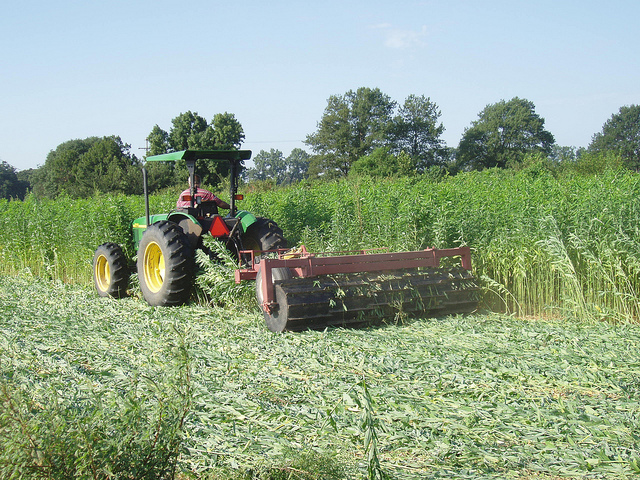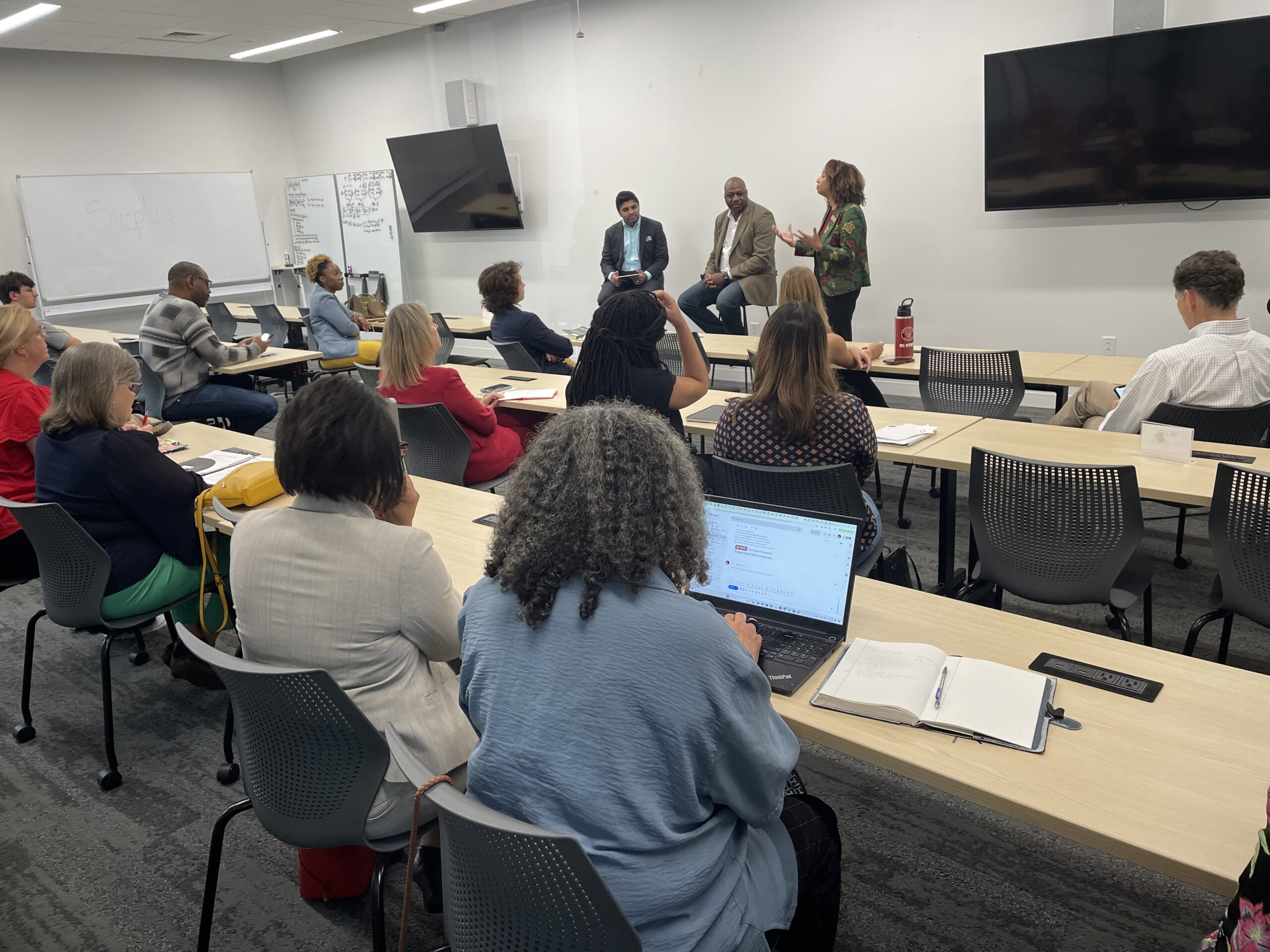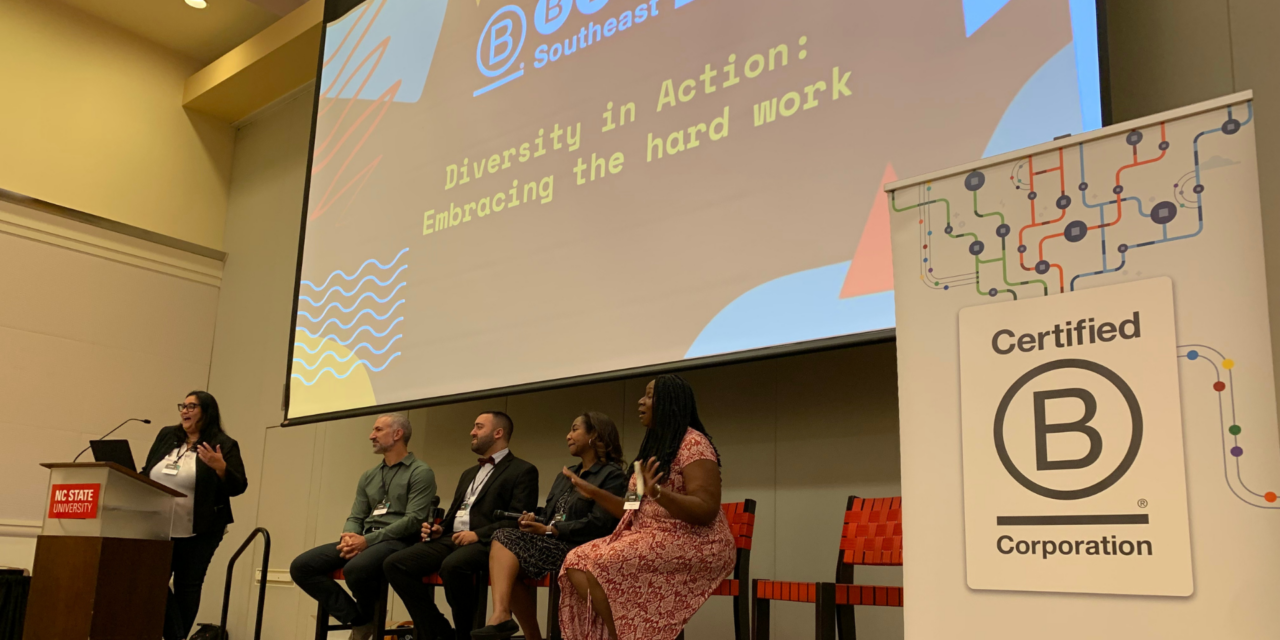Could carbon farming help reverse climate change?

New technologies like the roller crimper help farmers grow crops without releasing the carbon from their soils. Photo credit: SARE Outreach
This is the second part of an article about the Climate Adaptation Conference. The previous article can be found here.
Although agriculture is currently a major contributor to greenhouse gas emissions, some farms do the exact opposite, pulling carbon out of the atmosphere and sinking it into soils. If these carbon sequestering techniques spread to agricultural lands all across the globe, we could offset a huge portion of our yearly emissions and eventually bring the amount of carbon dioxide in the atmosphere down to safer levels.
During the keynote presentation at Abundance NC’s Climate Adaptation Conference last week, Peter Bane summarized the ways current agriculture exacerbates climate change, and described techniques farmers are already using to sequester carbon in their soils. According to Bane, agriculture is directly responsible for 9% of the 52 billion tons of carbon dioxide that humans pump into the atmosphere each year, and the food system as a whole is responsible for roughly a third of all emissions, including processing and transportation costs.
Putting Carbon Back in the Ground
Humans have a long history of releasing carbon into the atmosphere. Ever since we discovered how well crops grow on a cleared forest floor, we have been chopping down trees and tilling the soil. Over time, the plough become more efficient turning the organic matter in the soil into food for this year’s crop, steadily releasing the soils carbon into the atmosphere. In recent years, farmers have added many new sources of emissions, from petroleum-based fertilizers and the nitrous oxide they release, to the methane produced in confined animal feeding operations.
Farmers have also developed methods of sinking carbon and regenerating topsoils at impressive speeds. Joel Salatin of Polyface Farms does not put much faith in soil tests, but according to a recent measurement of soil organic matter, the Salatins have sunk an average of two tons of carbon per acre per year across the last 50 years. In Sabastapol, California, Paul Kaiser and Elizabeth Johnson of Singing Frogs Farm have used a no-till, intensive composting method to increase their soil organic matter from 2.4% in 2007 to over 10% today. Though these results are remarkable, many studies confirm that rotational grazing and no-till techniques can quickly return organic matter to degraded pastures and croplands.
Using data from a recent Rodale Institute study on regenerative agriculture, Bane calculated that if farmers implemented proven carbon sequestering practices on the planet’s 3.5 billion acres of croplands and 9 billion acres of pasture with average results (1.7 ton C/acre/yr on cropland and 1.1 ton C/acre/yr on pasture), agriculture would sequester about 58 billion tons of carbon dioxide each year, an amount greater than the 52 billion tons we annually emit. Bane emphasized that when sequestration outpaces emissions, we are talking about reversing climate change, rather than mitigating it.
When the plough blade turns the soil, it adds air and brings nutrients to the top, leading to an explosion of microbial activity. These microbes feast on the soils’ organic matter, making it bioavailable for plants growing on the surface. This is great for a farmers’ crops in the short term, but over time, ploughing depletes the soils’ organic matter, releases the carbon and destroys the soil structure. Carbon-sequestering agriculture, often referred to as carbon farming, breaks with traditional tilling methods and tries to produce food while replenishing the soils’ supply of organic matter, which is generally more than 50% carbon.
Attendees of this years Climate Adaptation Conference had a chance to learn more about agricultural practices that farmers are using to mitigate climate change, while producing high quality food at a profitable price.
Intensive Grazing
Grazing animals are often cast as one of the villains of climate change, with each cow adding roughly 100 kg of methane to the atmosphere each year. However, nitrogen-rich manure is also an important building block of healthy soils. Bane sees well-managed livestock as an important soil building tool. For him, problems arise when animals are raised away from the rest of the natural world. “The idea that we can separate plants and animals is sheer insanity.”
Every time a cow nibbles on a blade of grass, the plant kills off part of its roots, allowing it to become part of the soil organic matter. Occasional grazing is great for a pasture, as long as areas have time to recover after major disturbances. Left free to roam on a large pasture, cows will eat their favorite plants to the ground and inedible plants will soon dominate. Intensive grazing involves dividing a pasture into smaller paddocks, and then regularly moving the herd. The plants have time to regrow, and the manure mixes with the trampled plant debris to become good soil. This mimicks how herds of grazing animals naturally stay in a tight pack and continually move to new pastures when prey animals are present.
Well-managed intensive grazing can build topsoil at incredible speeds and provide animals with superior nutrition. A number of presenters mentioned Tom Trantham’s Happy Cow Creamery in South Carolina, where cows move to a new paddock each day, seeded with ideal fodder crops. Trantham started out as a traditional dairy farmer, using chemical inputs to grow grains, which he stored in a silo until the cows were ready for it. Although he was a top dairy producer, the cost of inputs kept him close to bankrupcy. On a fateful day in 1987, his cows escaped their concrete living quarters and feasted on an overgrown pasture. Trantham noticed an immediate spike in dairy production. After a few quick tests, he realized that raising cows on pasture made more sense.
Trantham has been tweaking his system ever since to try and give both his cows and pastures what they need to thrive. When he began in 1987, he had just eight paddocks, but now that number has grown to twenty-nine. Thanks to a USDA Sustainable Agricultural Research and Eduction (SARE) grant, Trantham travelled to Ireland where he learned the benefits of moving cows more regularly through smaller paddocks. He came back and developed the Twelve Aprils Grazing system, which has received international acclaim. The USDA now promotes the Twelve Aprils system as an alternative to grain-fed dairy. Trantham’s method allows dairy farmers to reduce dependence on chemical inputs and tillage, improves animal nutrition and steadily increases the soil organic matter and carbon content. Customers travel from miles away to purchase his high-quality milk, and the planet benefits from a slight decrease in carbon dioxide levels.
Organic No-Till
Bane called on farmers to trade in their ploughs for roller-crimpers. Rodale-Institute engineers recently developed the roller-crimper to make no-till farming possible for large-scale farmers who do not want to use herbicides to kill their weeds. The heavy crimper rolls over a cover crop, creating a thick mat that suppresses weeds and helps the soil retain moisture. As the new crop grows up, the cover crop decomposes and is incorporated into the soil. When the new crop is harvested, the roots are also left to decompose, depositing carbon deep into the subsoil.
Many conventional farmers have realized that ploughing depletes the soil and leads to erosion, and have found ways to grow crops without tillage. Unfortunately, this often leads to an increase in herbicide use as farmers look for other ways to control weeds. Organic no-till has proven incredibly successful on small farms, like Paul Kaiser’s Singing Frogs Farm in Sabastapol, but there are often high labor costs which prevent these methods from scaling to larger scale organic farms. The roller crimper may help change this.
Though Singing Frogs Farm is a labour-intensive operation, Kaiser is proud of the fact that he’s created year-round employment that pays a living wage. His no-till method builds soil organic matter at dizzying speeds, but it benefits from being close to an urban waste stream. The farm can only produce a third of the compost it needs each year. Much of the organic matter now in Singing Frogs’ soil actually comes from the Sonoma County Landfill, which produces 150 tons of compost every day. Kaiser applies more than 60 tons of compost on each acre every year, which explains how his soil organic matter increased by 300% in just five years. Thanks to Sonoma’s excess carbon and nitrogen, Singing Frog gets five to seven harvests of vegetables a year, grossing more than $100,000 an acre. Kaiser is proud of how much carbon he’s sequestered, but given California’s serious drought in recent years, he thinks that no-till’s most important selling point is soil organic matter’s ability to retain moisture.
Agroforestry and Perennial Based Systems
Another way to produce food without releasing carbon from the soil is to integrate perennial and tree crops into agricultural lands, which help to keep the soil in place and can offer yields of their own. Trees bodies are primarily made up of carbon, so cutting down a forest and burning the trees releases carbon into the atmosphere. When the tree roots die, there is nothing holding the topsoil in place and it begins to erode.
Agroforestry techniques like silvopasture and alley cropping allow farmers to obtain good yields in partially forested environments. Silvopasture involves integrating fodder, livestock and timber crops into a productive savannah, with multiple yields. At The Federation of Southern Cooperatives Training and Research Center, minority landowners learn how to use silvopasture to earn an annual income from livestock and hay while they wait for their timber crop to mature.
Alley cropping involves growing profitable crops in the alleys between rows of trees. At Walnut Meadows Ginseng Farm in West Virginia, Bill Sagle cultivates high-value ginseng in between the rows of walnut trees he uses for his carpentry business. At the Mountain Horticultural Crops Research & Extension Center, NCSU Professor Jeanine Davis has done research on a number of medicinal herbs and specialty crops that are in high demand and grow well in shade. During the heat of summer, shade may even be beneficial for traditional annual vegetable crops.
Bane pushed attendees to reduce reliance on annuals whenever possible. Annuals thrive in microbial dominant soils, which tend to decompose organic matter and release stored carbon. Perennials thrive in fungal dominated soils, which are better at holding on to carbon. Soil scientists recently discovered that the protein glomalin, which fungi produce to protect their hyphae, plays a critically important role in binding carbon molecules with clay and sand particles, forming soil aggregates.
Farmers can harvest from perennial crops year after year, without having to disturb the soil at all. During Guy Ames’ presentation on perennial fruit and nut production, he reported success using Badgersett’s hybrid varieties of hazelnuts. Chinese chestnuts are also reliable producers in south eastern climates. In Mark Shepard’s book on Restoration Agriculture, he points out that hazelnuts have a similar nutrient profile as soy beans and chestnuts are similar to corn. Shepard estimates that he produces more calories per acre from his diverse nut savannah on New Forest Farm than conventional farmers can produce using chemicals and tillage to grow commodity crops.
In the not too distant future, farmers may be able to establish high-yielding pastures of perennial grains. Researchers at the Land Institute in Salina, Kansas have already developed perennial varieties of wheat, sorghum and sunflowers. Though these new hybrid varieties do not yet produce enough yields to be commercially viable for most farmers, there are already restaurants and breweries touting products made with perennial grains. A decade from now, these new varieties could help grain farmers retire the plough and start putting carbon back into soil.
Making Agriculture Part of the Solution
The conference was filled with stories of farmers who already sequester an impressive amount of carbon per acre, but agriculture as a whole will likely remain a major contributor to climate change for many years to come. Farmers respond to incentives, and there are currently few cost associated with emitting carbon dioxide and nitrous oxide, and no reward for removing carbon from the atmosphere.
Although carbon-sequestration may not be incentivized as such, farmers like Salatin, Trantham, Kaiser and Shepard demonstrate that increasing soil organic matter offers plenty of benefits. Soil carbon helps retain water and nutrients and is the foundation of a healthy soil food web. Agricultural practices that build topsoil make farms more drought-resistant and often reduce the need for chemical inputs. Farms with healthy soils, filled with organic matter will be better prepared for the challenges climate change will bring. As Bane put it, “adaptation and mitigation come together in carbon farming.”
Bane stressed that restoration agriculture is only part of the solution. At some point, the American public will need to have a conversation about lifestyle adjustments, but he does not think the country is ready for that just yet. Carbon farming is an important plug to help mitigate the effects of climate change until we have the political will to seriously curb emissions. Shifting agricultural subsidies to reward farmers who sequester carbon in their soils will not solve the ecological crisis, but it would be an important first step, and could buy some time.
The Need for New Stories
As critically important as carbon farmers will be for mitigating climate change, a number of presenters stressed the need for artists and storytellers to help change how our culture thinks about farming. Guy Ames finished his presentation with a quote from permaculture co-founder, David Holmgren: “There is a desperate need to recast energy descent as a positive process that can free people from the strictures and dysfunctions of growth economics and consumer culture.”
Ames pointed out that the media is filled with apocalyptic stories about collapse scenarios right now, but there are a serious shortage of stories about how slowing down and living more locally could actually provide a higher quality of life. He mentioned the last episode in Kurosawa’s Dreams, where the surviver of a nuclear holocaust wanders into a village of windmills. In this village, people live joyfully without technology or pollution, providing for one another in a thick community. “Who wouldn’t want to live in a world like that?” Ames asked.
Such stories, where abandoning fossil fuels is seen in a positive light, will be fundamental to building the political will to address climate change.
Village of the Watermills|Akira Kurosawa from Sumana on Vimeo.
- Categories:


